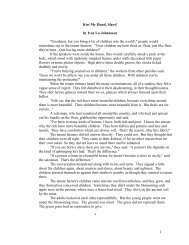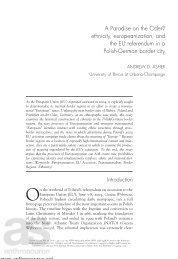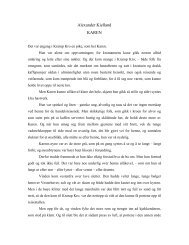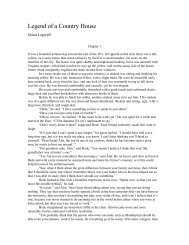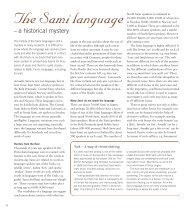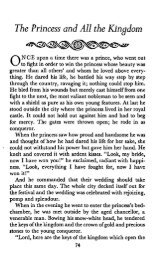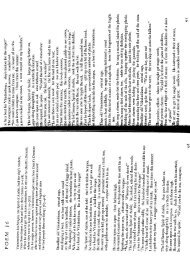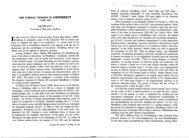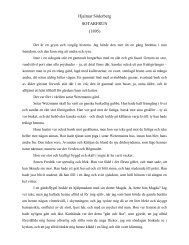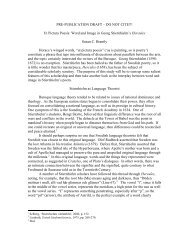Six Views of “The Little Mermaid” - Department of Scandinavian ...
Six Views of “The Little Mermaid” - Department of Scandinavian ...
Six Views of “The Little Mermaid” - Department of Scandinavian ...
You also want an ePaper? Increase the reach of your titles
YUMPU automatically turns print PDFs into web optimized ePapers that Google loves.
152 SCANDINAVIAN STUDIES SPLASH!<br />
153<br />
any mortal couple. With the destruction <strong>of</strong> the sea witch, the beings <strong>of</strong> the<br />
sea can also live ha pily ever after-under their proper ruler, “the king.”<br />
Disney’s neat P olktale ending is satisfying, but its change in emphasis<br />
from the strength <strong>of</strong> good to the strength <strong>of</strong> evil in female power is<br />
troubling, even though the substitution <strong>of</strong> mortal love, mos, for spiritual<br />
love, agape, is familiar from pr<strong>of</strong>ane ideas <strong>of</strong> happiness, both ancient and<br />
modern. The public seems to prefer lovers to saints-and Disney assumes it<br />
prefers a definite patriarchy to the ambiguities <strong>of</strong> a matriarchy.<br />
Note<br />
’ When one fairly clear-cut and restricted approach is taken, as it is above, an exhaustive<br />
reading cannot and should not be expected. Such matters as the text’s ambiguities and its<br />
ideological and artistic problems might have eventually been discussed, but only if departures<br />
were to be taken from this quite formal approach; thus, that more complete reading <strong>of</strong> the<br />
text could only be achieved if the text were examined in a dialogic manner-that is, in<br />
conjunction with the other methods, so that light could be shed on the text from various<br />
angles. Andersen’s multilevel texts tend to require such teamwork, but the folkloristic<br />
approach puts the tale into a intertextual genre-framework that suggests both its proximity to,<br />
and distance from, the tradition that was one <strong>of</strong> Andersen’s inspirations.<br />
A Synopsis<br />
Gre ory Nybo<br />
University opCalifornia, Berkeley<br />
T<br />
HIS IS not so much a story about unrequited love as it is about death<br />
and our ingenious subterfuges in trying to deny its existence and escape<br />
from it.<br />
On the immediate level <strong>of</strong> the fairy tale and moral fable we seem indeed<br />
to be <strong>of</strong>fered a moving love story, but with complications. There is that<br />
puzzling ending, for one: when the grief-stricken Mermaid is “saved” by the<br />
air spirits, she is rewarded for her “striving” with a prize, we are left to<br />
surmise, that is even nobler than human love: the promise <strong>of</strong> an immortal<br />
life. This gives the love story an unusual turn. For if the immortal life<br />
promised to the Mermaid is a better bargain than the love she has been<br />
striving to “win,” the logic <strong>of</strong> the story is turned on its head. Instead <strong>of</strong><br />
being a tale <strong>of</strong> a human love that prevails through selfless suffering and<br />
striving, it becomes a tale in which such love is denied and sublimated to a<br />
“higher” dimension, removed from the tainted realm <strong>of</strong> the human. Read<br />
this way, <strong>“The</strong> <strong>Little</strong> <strong>Mermaid”</strong> may well be a tale that does not celebrate<br />
human love but renounces it.<br />
This unusual turn ought not take us by complete surprise. In fact, it<br />
seems to be anticipated by a certain, hidden logic in the tale, a logic that<br />
generates persistent and troubling ambiguities and dislocations, beginning on<br />
page one. We have the sense, for example, that more than one story is being<br />
told, that the narrator seems wholly unaware <strong>of</strong> this, and that he keeps<br />
telling his story “as if” it were a tale <strong>of</strong> love, while his subtext, which does<br />
not, keeps compromising, contradicting, and even resisting the story he tells<br />
“in the lines.” A closer reading seems to confirm this curious “split logic”<br />
in the tale. From the beginning, the Mermaid is presented as a young<br />
woman <strong>of</strong> unusual sensitivity and longing. After she meets and falls in love<br />
with the Prince, she is also resented “in the lines” as a selfless and devoted<br />
young woman willing to su P fer any sacrifice for the sake <strong>of</strong> her beloved. The<br />
narrator also and quite clearly means to convince us that her affections and<br />
faith are being callously exploited b a narcissistic prince.<br />
The subtext, however, procee dy s along a different path. Beneath the<br />
rhetoric that supports her selfless devotion, there is a cooler and subtextual<br />
“quest” afoot, subtly revealed in her early infatuation with the statue: her<br />
passion for it is not just a s<strong>of</strong>t and romantic dream (if that at all) <strong>of</strong> a prince<br />
<strong>of</strong> flesh and blood, a sexual and changeable being who will reciprocate<br />
feelings <strong>of</strong> deep affection, but a cooler “passion” for a bloodless image cut<br />
in marble, fixed in substance and form. The Mermaid, at this subtextual<br />
level, does not want to realize herself in the mutuality <strong>of</strong> human love, the<br />
meeting <strong>of</strong> two hearts, which includes sexuality, but wants to “contain” and<br />
control those energies, rise “above” them. At this level, which looks<br />
suspiciously like the domain <strong>of</strong> the repressed, the Mermaid’s “love story”<br />
begins with the “denial” <strong>of</strong> a crucial constituent in the love between the<br />
woman and the man: sexuality and the spontaneous flow <strong>of</strong> emotion. The<br />
more precise motive for the Mermaid’s “quest” for the Prince’s affections<br />
is therefore to sublimate human love, bring it under control, and make it<br />
serve a “higher” purpose. “Her” purpose. The perspective emerging is<br />
troublesome.<br />
A subset <strong>of</strong> this motive is presently revealed in the story. In an early<br />
conversation with her grandmother, the Mermaid admits that her deepest<br />
lon ing is not for a prince <strong>of</strong> flesh and blood, not even for a splendid<br />
we c! ding, nor indeed for a love that extends itself to another, but<br />
for-immortality. This startling disclosure, although unacknowledged “in the<br />
lines,” reveals the deepest and most troublin motive for her quest: it is not<br />
love, not the affirmation <strong>of</strong> another or <strong>of</strong> li B e, but fear. An abiding fear <strong>of</strong><br />
death. The narrator predictably fails to acknowledge or see through this<br />
somber motive in his heroine. Instead, and as if in collusion with her, he<br />
assists the Mermaid in taking practical advantage <strong>of</strong> something the<br />
Grandmother tells her: if a Mermaid can “make” a human being love her<br />
well enough, he may give her an immortal soul. It is with the business<br />
version <strong>of</strong> this suggestion in mind that she now proceeds to strike a bargain<br />
with the sea witch. She submits to this horrible mutilation, which also is the<br />
symbolic and radical denial <strong>of</strong> her own identity, for reasons that now stand<br />
revealed as entirely self-serving and from a motive that is purely solipsistic<br />
and negative, that is, fear <strong>of</strong> death. Judged by her zeal in trying to secure<br />
immortality for herself and for herself alone, this fear must be consuming.



